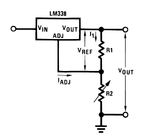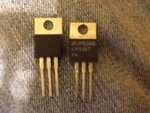addisonElliott
Newbie level 6
Hello, the title just about says it all but I will give a little detail in what I mean. My place of choice to buy electronic components is ebay for now. It usually has free shipping on almost all of the stuff, has comparable prices, and I don't have a cheap local alternative. When buying parts from China, it usually does take a few weeks but it is cheap and if I buy it early enough, I can just forget about it and wait until it comes. (If anyone has a good website that sells electronic components for free shipping then that would be great to know about)
Anyways, I haven't had any problems with defective items until now it seems. I am pretty new to electronics, so it was my first time with these components so there is a chance that it's me using it wrong, but I doubt it. The first component I had was a LM338 adjustable voltage regulator. I did a simple circuit of INPUT to +26V, 240 ohm resistor from ground to adj, and also from +26V to adj. This should output around 1.25V, but instead I got 6V.
The next component was a TPIC6B595N 8-bit shift register. I hooked it SRCK, RCK, and SER IN to atmega8, G to GND, SRCLR to +5V, and the outputs to LEDs. I then changed SRCK from low to high 8 times, changing the SER IN pin and then set RCK to HIGH. Nothing happened. Checked all the connections and they are fine.
Both of these parts were from Chinese suppliers. Has anyone else had any problems with items like this? I hope it is me; they are good deals and keeps me in the business of learning more about electronics. I don't always buy in bulk, and if I have to pay $7 shipping, I might as well which discourages me from buying anything a lot of times.
Anyways, I haven't had any problems with defective items until now it seems. I am pretty new to electronics, so it was my first time with these components so there is a chance that it's me using it wrong, but I doubt it. The first component I had was a LM338 adjustable voltage regulator. I did a simple circuit of INPUT to +26V, 240 ohm resistor from ground to adj, and also from +26V to adj. This should output around 1.25V, but instead I got 6V.
The next component was a TPIC6B595N 8-bit shift register. I hooked it SRCK, RCK, and SER IN to atmega8, G to GND, SRCLR to +5V, and the outputs to LEDs. I then changed SRCK from low to high 8 times, changing the SER IN pin and then set RCK to HIGH. Nothing happened. Checked all the connections and they are fine.
Both of these parts were from Chinese suppliers. Has anyone else had any problems with items like this? I hope it is me; they are good deals and keeps me in the business of learning more about electronics. I don't always buy in bulk, and if I have to pay $7 shipping, I might as well which discourages me from buying anything a lot of times.

